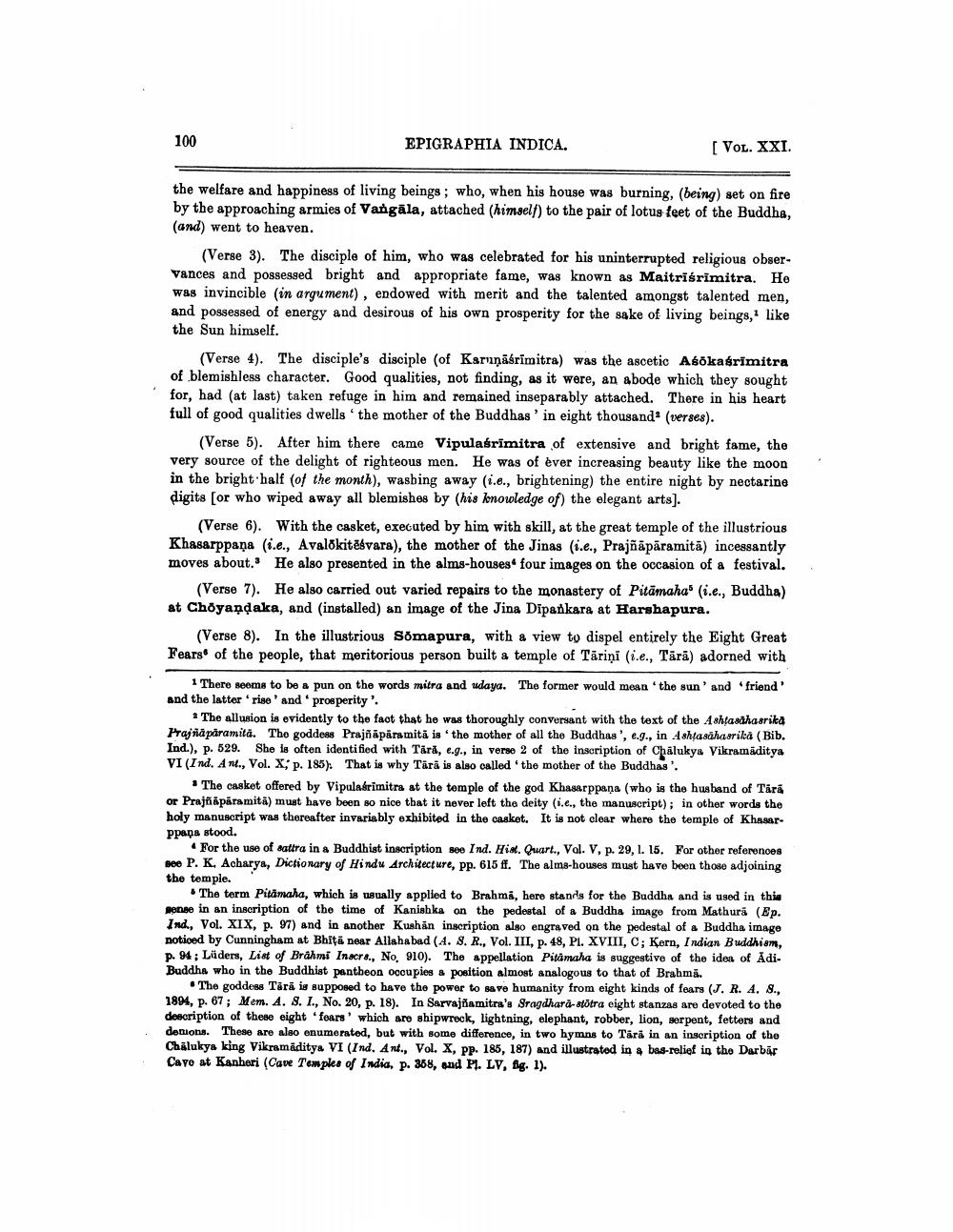________________
100
EPIGRAPHIA INDICA.
[ Vol. XXI.
the welfare and happiness of living beings; who, when his house was burning, (being) set on fire by the approaching armies of Vangāla, attached (himself) to the pair of lotus feet of the Buddha, (and) went to heaven.
(Verse 3). The disciple of him, who was celebrated for his uninterrupted religious obserVances and possessed bright and appropriate fame, was known as Maitrisrimitra. He was invincible (in argument), endowed with merit and the talented amongst talented men, and possessed of energy and desirous of his own prosperity for the sake of living beings, like the Sun himself.
(Verse 4). The disciple's disciple (of Karuņāśrimitra) was the ascetic Abókasrimitra of blemishless character. Good qualities, not finding, as it were, an abode which they sought for, had (at last) taken refuge in him and remained inseparably attached. There in his heart full of good qualities dwells the mother of the Buddhas' in eight thousand (verses).
(Verse 5). After him there came Vipulasrimitra of extensive and bright fame, the very source of the delight of righteous men. He was of ever increasing beauty like the moon in the bright half of the month), wasbing away (i.e., brightening) the entire night by nectarine digits (or who wiped away all blemishes by (his knowledge of) the elegant arts).
(Verse 6). With the casket, executed by him with skill, at the great temple of the illustrious Khasarppaņa (i.e., Avalokitesvara), the mother of the Jinas (i.e., Prajñāpāramitā) incessantly moves about. He also presented in the alms-houses four images on the occasion of a festival.
(Verse 7). He also carried out varied repairs to the monastery of Pitämaha (i.e., Buddha) at Choyandaka, and (installed) an image of the Jina Dipankara at Harshapura.
(Verse 8). In the illustrious Somapura, with a view to dispel entirely the Eight Great Fears of the people, that meritorious person built a temple of Tāriņi (i.e., Tārā) adorned with
There seems to be a pun on the words mitra and udaya. The former would mean the sun and friend and the latter rise and prosperity.
* The allusion is evidently to the faot that he was thoroughly conversant with the text of the Ashtaadhaarika Prajnaparamita. Tho goddess Prajnaparamita is the mother of all the Buddhas', e.g., in Ashtashaarila (Bib. Ind.), p. 529. She is often identified with Tårde.g., in verse 2 of the Inscription of Chalukya Vikramaditya VI (Ind. A nt., Vol. X, p. 185). That is why Tára is also called the mother of the Buddhas'.
• The casket offered by Vipuladimitrs at the temple of the god Kharppana (who is the husband of Tira or Prajti aparamita) must have been so nice that it never left the deity i.e., the manuscript); in other words the holy manuscript was thereafter invariably exhibited in the casket. It is not clear where the temple of Khasar Ppaps stood.
For the use of attra in a Buddhist inscription see Ind. His. Quart., Vol. V, p. 29, L. 15. For other references se P. K. Acharya, Dictionary of Hindu Architecture, pp. 615 ff. The alma-houses must have been those adjoining the temple.
The term Pitamaha, which is uually applied to Brahms, here stands for the Buddha and is used in this mense in an inscription of the time of Kanishka on the pedestal of a Buddha image from Mathurá (Ep. Ind., Vol. XIX, p. 97) and in another Kushan inscription also engraved on the pedestal of a Buddha image noticed by Cunningham at Bhita near Allahabad (4. 8. R., Vol. III, p. 48, Pl. XVIII, C; Kern, Indian Buddhism, p. 94: Lüders, List of Brahmi Inacra., No. 910). The appellation Pitamaha is suggestive of the idea of Adi. Buddha who in the Buddhist pantheon occupies & position almost analogous to that of Brahmi.
• The goddess Tára is supposed to have the power to save humanity from eight kinds of fears (J. R. 4. 8., 1894, p. 67; Mem. A. 8. I., No. 20, p. 18). In Sarvajñamitra's Sragdhard-stötra eight stanzas are devoted to the description of these eight foars which are shipwrock, lightning, elephant, robber, lion, serpent, fetters and doniona. These are also enumerated, but with some difference, in two hymns to Tärá in an inscription of the Chalukya king Vikramaditya VI (Ind. An., Vol. X, PP. 185, 187) and illustrated in a bas-relief in the Darbar Cayo at Kanheri (Cave Temples of India, p. 358, and P. LV, fig. 1).




